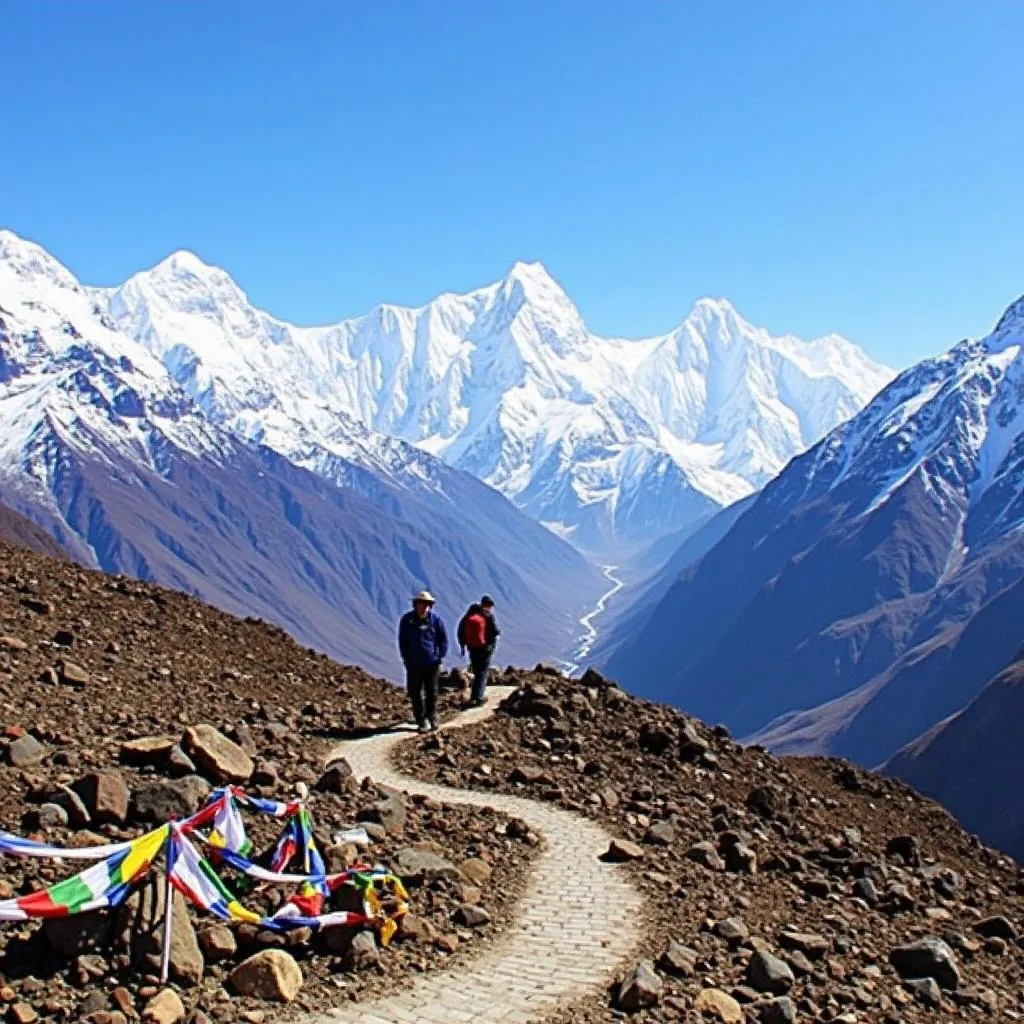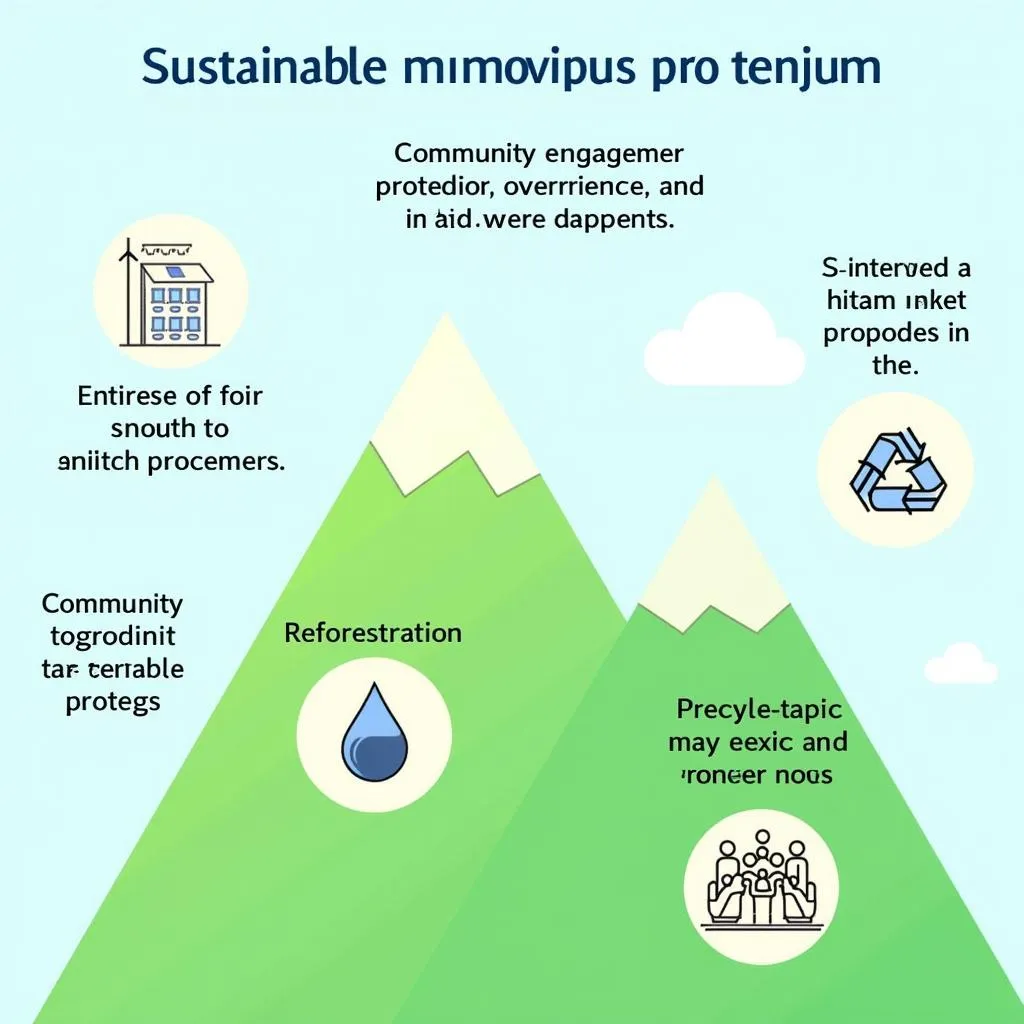The ability to effectively describe a place, especially one you would like to visit, is a crucial skill in the IELTS Speaking test. This topic has been a consistent favorite among examiners and is likely to remain relevant in future tests. Let’s explore how to excel when asked to “describe a place in the mountains where you would like to go.”
Part 1: Introduction and Interview
In this section, the examiner may ask general questions about mountains and travel preferences. Here’s a sample question with a suggested answer:
Q: Do you enjoy visiting mountainous areas?
A: Absolutely! I find mountain landscapes incredibly captivating. There’s something awe-inspiring about towering peaks and pristine wilderness that never fails to take my breath away. I particularly enjoy the sense of tranquility and connection with nature that mountain environments provide.
Part 2: Long Turn
Cue Card
Describe a place in the mountains where you would like to go.
You should say:
- Where it is
- What you can do there
- Who you would like to go with
- And explain why you would like to go to this place
Sample Answer (Band 6-7):
I’d like to talk about a mountain destination I’ve been dreaming of visiting – the Swiss Alps, specifically the area around Zermatt. It’s a picturesque region in southern Switzerland, known for its stunning Alpine scenery and world-class ski resorts.
In Zermatt, there’s a wide range of activities to enjoy. During winter, it’s a paradise for skiing and snowboarding enthusiasts. In summer, you can go hiking, mountain biking, or even try your hand at rock climbing. One of the main attractions is the iconic Matterhorn peak, which offers breathtaking views and photo opportunities.
I’d love to go there with my best friend, who shares my passion for outdoor adventures. We’ve talked about taking a trip like this for years, and I think it would be an unforgettable experience to share together.
The reason I’m so drawn to this place is its perfect blend of natural beauty and outdoor recreation. I’m fascinated by the idea of being surrounded by snow-capped peaks and pristine mountain lakes. Plus, the chance to challenge myself with new activities like skiing or hiking at high altitudes really appeals to my adventurous side.
Sample Answer (Band 8-9):
I’d be delighted to share with you my aspirations of visiting the awe-inspiring Himalayas, specifically the Annapurna region in Nepal. This magnificent mountain range, home to some of the world’s highest peaks, has long captivated my imagination with its raw beauty and rich cultural heritage.
The Annapurna region offers a plethora of activities for nature enthusiasts and adventure seekers alike. The crown jewel of the area is undoubtedly the Annapurna Circuit trek, a legendary route that winds through diverse landscapes, from lush subtropical forests to barren high-altitude deserts. For those seeking a more intense challenge, there are opportunities for technical climbing on some of the lesser-known peaks. Additionally, the region is dotted with traditional villages where one can immerse oneself in the local Nepali and Tibetan cultures, providing a perfect balance of physical adventure and cultural exploration.
I’ve always envisioned undertaking this journey with my sister, who shares my passion for outdoor pursuits and cultural immersion. We’ve often discussed how such an expedition would not only test our physical limits but also strengthen our bond through shared experiences and challenges.
The allure of the Annapurna region lies in its unparalleled combination of natural grandeur and cultural richness. The prospect of standing amidst towering peaks, some exceeding 8,000 meters, fills me with a sense of humility and wonder at the magnificent forces of nature. Moreover, the opportunity to interact with local communities, learn about their traditions, and gain insight into their harmonious coexistence with this harsh yet beautiful environment is incredibly appealing. I believe such an experience would be transformative, offering not just breathtaking vistas but also profound personal growth and a deeper appreciation for the diversity of our world.
 Annapurna Circuit Trek in the Himalayan Mountains
Annapurna Circuit Trek in the Himalayan Mountains
Follow-up Questions
Q: What kind of preparation would you need to make for such a trip?
A (Band 6-7): I’d need to do quite a bit of preparation. First, I’d have to work on my physical fitness, maybe by doing some regular hiking or cardio exercises. I’d also need to research the best time to visit and what gear to bring. It would be important to learn about altitude sickness and how to prevent it too.
A (Band 8-9): Embarking on such an expedition would necessitate meticulous preparation across various fronts. Physically, I’d need to engage in a rigorous training regimen, focusing on cardiovascular endurance and strength training to cope with the demands of high-altitude trekking. Equally crucial would be acclimatization strategies to mitigate the risks of altitude sickness. I’d also need to familiarize myself with the local customs and basic Nepali phrases to foster meaningful interactions with the communities we’d encounter. Additionally, thorough research into the region’s climate patterns, permit requirements, and ecological best practices would be essential to ensure a responsible and well-planned journey.
Q: How do you think tourism affects mountain communities?
A (Band 6-7): Tourism can have both positive and negative effects on mountain communities. On the positive side, it brings in money and job opportunities for locals. But it can also lead to overcrowding and damage to the environment if not managed properly. It’s important for tourists to be respectful and follow local guidelines to minimize their impact.
A (Band 8-9): The impact of tourism on mountain communities is multifaceted and often paradoxical. On one hand, it can be a catalyst for economic development, providing employment opportunities and incentivizing the preservation of cultural heritage and natural landscapes. This influx of resources can lead to improved infrastructure and healthcare facilities, elevating the overall quality of life for local residents.
Conversely, unregulated tourism can pose significant challenges. The delicate mountain ecosystems are particularly vulnerable to environmental degradation caused by increased foot traffic, waste accumulation, and resource consumption. Moreover, there’s a risk of cultural erosion as traditional ways of life adapt to cater to tourist expectations.
The key lies in implementing sustainable tourism practices that strike a balance between economic benefits and environmental conservation. This could involve setting visitor caps, promoting eco-friendly accommodations, and engaging local communities in tourism management to ensure they are active stakeholders rather than passive recipients of tourism’s effects.
Describe a time when you went on a nature hike can provide valuable insights into how to discuss outdoor experiences effectively in your IELTS Speaking test.
Part 3: Two-way Discussion
Q: Do you think mountain tourism will become more popular in the future?
A (Band 6-7): Yes, I think mountain tourism will likely become more popular. People are increasingly looking for unique experiences and ways to connect with nature. Mountains offer both adventure and a chance to escape from busy city life. However, this could also lead to problems like overcrowding and environmental damage if not managed carefully.
A (Band 8-9): I firmly believe that mountain tourism is poised for significant growth in the coming years, driven by several converging factors. Firstly, there’s a growing global consciousness about health and wellness, with many individuals seeking activities that offer both physical challenges and mental rejuvenation – attributes inherently associated with mountain environments.
Moreover, the rise of experiential travel and the quest for authentic, transformative experiences aligns perfectly with what mountain destinations can offer. Mountains provide not just scenic beauty, but opportunities for personal growth, cultural immersion, and a profound connection with nature – elements that are increasingly valued by modern travelers.
However, this projected increase in popularity also raises important considerations. The fragile ecosystems of mountain regions may face unprecedented pressures from increased human activity. This necessitates a proactive approach to sustainable tourism practices, potentially including the implementation of visitor quotas, the development of eco-friendly infrastructure, and education programs to foster responsible tourist behaviors.
Furthermore, the impact of climate change on mountain environments cannot be overlooked. As glaciers recede and weather patterns shift, the very landscapes that attract tourists are undergoing dramatic changes. This could lead to a surge in ‘last-chance tourism’ – people rushing to experience these environments before they are irrevocably altered.
In conclusion, while I anticipate a rise in mountain tourism, it’s crucial that this growth is managed sustainably, balancing economic benefits with environmental preservation and respect for local cultures.
Q: How can we balance tourism development with environmental protection in mountain areas?
A (Band 6-7): Balancing tourism and environmental protection is challenging but important. We could limit the number of tourists allowed in certain areas, promote eco-friendly practices like using renewable energy, and educate visitors about the importance of preserving the environment. It’s also crucial to involve local communities in decision-making about tourism development.
A (Band 8-9): Striking a balance between tourism development and environmental protection in mountain regions requires a multifaceted, collaborative approach. At its core, this balance hinges on the principle of sustainable tourism, which aims to minimize negative impacts while maximizing benefits for local ecosystems and communities.
One key strategy is the implementation of carrying capacity assessments and visitor management systems. By scientifically determining the number of visitors an area can sustainably accommodate, authorities can set appropriate limits and distribute tourist flows more evenly across regions and seasons. This approach not only protects sensitive ecosystems but also enhances the quality of visitor experiences.
Another crucial aspect is the adoption of green infrastructure and technologies. This could include the development of energy-efficient accommodations, waste management systems that prioritize recycling and composting, and the use of renewable energy sources. Such initiatives not only reduce the environmental footprint of tourism but can also serve as educational tools for visitors.
Education and awareness programs play a vital role in this balancing act. By fostering a deep appreciation for mountain ecosystems among tourists, we can cultivate a sense of stewardship that encourages responsible behavior. This could involve interpretive trails, guided nature walks, and interactive exhibits that highlight the fragility and importance of mountain environments.
Moreover, engaging local communities as active stakeholders in tourism development is essential. Their traditional knowledge and practices often embody sustainable principles that have preserved these environments for generations. By empowering local communities to participate in and benefit from tourism, we can ensure that economic incentives align with conservation goals.
Lastly, the implementation of rigorous monitoring and adaptive management strategies is crucial. Regular assessments of environmental indicators, coupled with flexible policies that can respond to changing conditions, allow for continuous improvement and adjustment of tourism practices.
In essence, balancing tourism development with environmental protection in mountain areas requires a holistic, long-term vision that recognizes the intrinsic value of these ecosystems beyond their touristic appeal. It’s about fostering a form of tourism that not only minimizes harm but actively contributes to the preservation and regeneration of mountain environments.
 Sustainable Mountain Tourism Practices
Sustainable Mountain Tourism Practices
Describe a place in nature that makes you feel peaceful can help you articulate the emotional impact of natural settings, which is valuable when discussing mountain destinations.
Key Vocabulary and Phrases for High Scores
-
Awe-inspiring /ɔː ɪnˈspaɪərɪŋ/ (adjective): Extremely impressive or daunting; inspiring great admiration.
Example: The towering peaks of the Himalayas present an awe-inspiring sight. -
Pristine /ˈprɪstiːn/ (adjective): In its original condition; unspoiled.
Example: The mountain lake was pristine, reflecting the surrounding peaks like a mirror. -
Biodiversity /ˌbaɪəʊdaɪˈvɜːsəti/ (noun): The variety of plant and animal life in a particular habitat.
Example: The Andes mountains are known for their rich biodiversity, hosting numerous unique species. -
Ecotourism /ˈiːkəʊˌtʊərɪzəm/ (noun): Tourism directed toward exotic, often threatened, natural environments, intended to support conservation efforts and observe wildlife.
Example: The national park promotes ecotourism to protect the fragile mountain ecosystem. -
Panoramic /ˌpænəˈræmɪk/ (adjective): (of a view) Unobstructed and wide-ranging.
Example: From the summit, we enjoyed a panoramic view of the surrounding valleys and peaks. -
Sustainable /səˈsteɪnəbl/ (adjective): Able to be maintained at a certain rate or level without depleting natural resources.
Example: The local community is committed to sustainable tourism practices to preserve the mountain environment. -
Picturesque /ˌpɪktʃəˈresk/ (adjective): Visually attractive, especially in a quaint or charming way.
Example: The picturesque Alpine village nestled in the valley was like something out of a postcard. -
Serene /səˈriːn/ (adjective): Calm, peaceful, and untroubled.
Example: The serene atmosphere of the mountain retreat provided a perfect escape from city life.
Describe a place in nature that you think everyone should visit can provide additional inspiration for describing natural wonders and their impact on visitors.
Examiner’s Advice
To achieve a high score in the IELTS Speaking test when describing a place in the mountains:
-
Use varied vocabulary: Incorporate a range of descriptive words and phrases to paint a vivid picture of the mountain setting.
-
Provide specific details: Instead of general statements, offer concrete examples and descriptions that bring your chosen location to life.
-
Show enthusiasm: Your tone and expression should convey genuine interest in the topic, enhancing the overall impact of your response.
-
Structure your answer: Organize your thoughts logically, covering all aspects mentioned in the cue card systematically.
-
Extend your responses: In Part 3, develop your answers with explanations, examples, and personal opinions to demonstrate your ability to discuss abstract ideas.
-
Practice fluency: Regular practice will help you speak more smoothly and confidently about various topics related to mountains and travel.
-
Engage with the examiner: Make eye contact and respond naturally to follow-up questions, showing your ability to participate in a real conversation.
Remember, the key to success in the IELTS Speaking test is not just about what you say, but how you say it. Confidence, fluency, and the ability to express your thoughts clearly are crucial factors in achieving a high score.
Describe a nature hike you took and what you saw offers excellent practice for describing outdoor experiences, which can be applied to mountain scenarios as well.
By following these guidelines and practicing regularly, you’ll be well-prepared to excel in your IELTS Speaking test, particularly when discussing mountain destinations or any other nature-related topics.


